Hey there, Malaysian! Have you taken care of your income tax filing yet?
It’s something we tend to forget about each year, but filing your income tax is important for all of us as residents. It’s our responsibility to report and pay taxes if we’re eligible under the tax laws.
When you file your taxes, you not only confirm your income for official reasons, but it also makes it easier for you to access special government assistance.
But! If you’re new to filing taxes, you might have these misconceptions:
- Filing income tax is only for those who earn more than RM XXX annually.
- Filing income tax = Paying tax
- Filing income tax is troublesome and involves a lot of procedures
But, that’s not the case!
First, filing income tax is not the same as paying tax. Thus, it’s not something that you only need to do if your “annual income exceeds xxx amount.”
If you’re uncertain about how, when, and where to file your income tax, especially if it’s your first time, we’re here to assist you.
Check out our easy step-by-step guide to help you through the process.

How to file your income tax in 2026
- 1. What is filling in income tax?
- 2. Who needs to do tax filing?
- 3. Do freelancers pay income tax in Malaysia?
- 4. What is the minimum salary to pay income tax in Malaysia?
- 5. How to file your tax online?
- 6. How do I register for LHDN for the first time?
- 7. How do I submit my income tax filing? (Step-by-Step)
- 8. How do I file a return after the due date?
- 9. Extra tips: Filing income tax as a foreigner
- Frequently Asked Questions (FAQ)
1. What is filling in income tax?
From 1st March each year, employees and taxpayers can begin filing their income tax returns using the e-Filing system which can be obtain at mytax.hasil.gov.my.
Unlike traditional methods where you manually fill out printed forms, e-Filing automatically calculates your income tax for you.
2. Who needs to do tax filing?
No matter you are self-employed or employed, all income earned in Malaysia, including salary and commission, is taxable.
We pay our taxes (cukai, which is tax in Malay) to the Inland Revenue Board of Malaysia (LHDNM – Lembaga Hasil Dalam Negeri Malaysia).
Effective since 2015, the law states that an individual employed in Malaysia that earns an annual employment income of RM34,000 (after EPF deduction) has to register for a tax file.
3. Do freelancers pay income tax in Malaysia?
When you work as a freelancer, you have the freedom to set your own schedule. However, you will still need to file your taxes once their annual income exceeds RM36,000 annually.
All the money you earn from freelancing is considered business income if you’re registered as a sole proprietor.
This can actually be helpful because it means you can deduct certain expenses from your taxes, which you can’t do with personal spending accounts.
But good news to individuals who are earning income from abroad (foreign-sourced income). You are exempted from paying taxes – but only if you are already taxed in the country of origin.
This arrangement will be valid until 31 December 2026.

4. What is the minimum salary to pay income tax in Malaysia?
Any individual who earns a minimum of RM 34,000 after EPF deductions.
It means individuals who earn RM 2,833 per month after EPF deductions from their salary or around RM 3,000 net.
The RM 34,000 is not only your income from work, but it should include all of your income into account.
Attached is the income tax rate as of year of assessment 2026:
| Chargeable Income | Calculation (RM) | Rate( %) | Tax(RM) |
|---|---|---|---|
| 0 – 5,000 | On the first 5,000 | 0 | 0 |
| 5,001 – 20,000 | On the first 5,000 Next 15,000 | 1 | 0 150 |
| 20,001 – 35,000 | On the first 20,000 Next 15,000 | 3 | 150 450 |
| 35,001 – 50,000 | On the first 35,000 Next 15,000 | 6 | 600 900 |
| 50,001 – 70,000 | On the first 50,000 Next 20,000 | 11 | 1,500 2,200 |
| 70,001 – 100,000 | On the first 70,000 Next 30,000 | 19 | 3,700 5,700 |
| 100,001 – 400,000 | On the first 100,000 Next 300,000 | 25 | 9,400 75,000 |
| 400,001 – 600,000 | On the first 400,000 Next 200,000 | 26 | 84,400 52,000 |
| 600,001 – 2,000,000 | On the first 600,000 Next 1,400,000 | 28 | 136,400 392,000 |
| Exceeding 2,000,000 | On the first 2,000,000 Next ringgit | 30 | 528,400 |
Overwhelmed by the numbers? Don’t worry! With the help of advanced technology, you can always file your tax online.
What’s better? The system will automatically calculate the payable amount for you!
5. How to file your tax online?
First things first! The due date for submission of Income Tax Returns is:
- Individuals without a business source: On or before 30 April every year
- Individuals with a business source: On or before 30 June every year
There are also some preparations to do in advance:
- Save your Income Tax Reference Number (No Rujukan Cukai): The one starts with SGXXXXXXX.
- Save your e-Filing PIN.
You can either visit the nearest LHDN office to apply for both. Or apply them online.
How to apply online as first timer?
Step 1: Go to mytax.hasil.gov.my to apply for your Income Tax Reference Number.
2. Click “Online Registration Form” (Borang Pendaftaran Online), fill in your details, and log in to your account.
3. To get your e-Filing PIN, go to LHDN’s website: Feedback>Application.
4. Select e-Filing PIN Number Application.
However, we recommend you to cut the waiting time and straight away visit your nearest LHDN branch as the staff can assist you with all the applications.
There, you will get your PIN Number straight away without having to wait for them to reply you via email.
6. How do I register for LHDN for the first time?
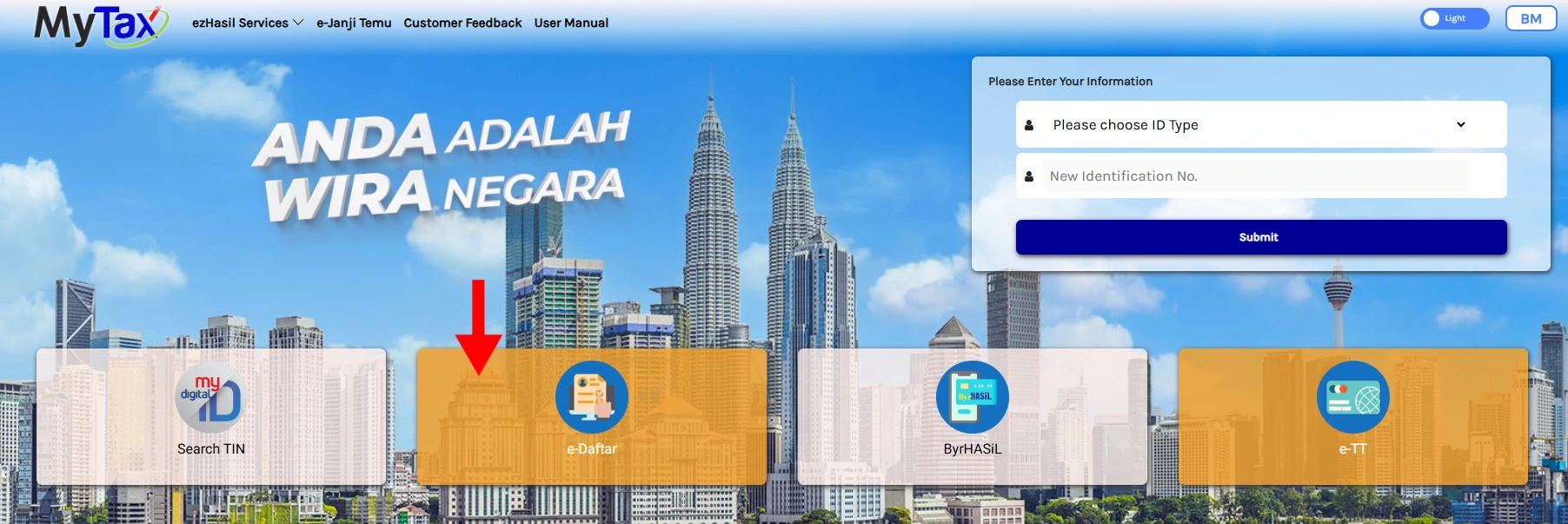
If this is your first time logging in, please choose ‘e-Daftar‘ on the MyTax website, and then fill in your PIN and identity your Identity Card (IC) number to complete the first step.
You will then have to fill in an online form and upload a digital copy of your Identification Card (IC) to serve as a supporting document.
Again, you will then receive your PIN online, or if you prefer, you can visit the nearest LHDN branch to retrieve your PIN right away.
7. How do I submit my income tax filing? (Step-by-Step)
Step 1: Log in
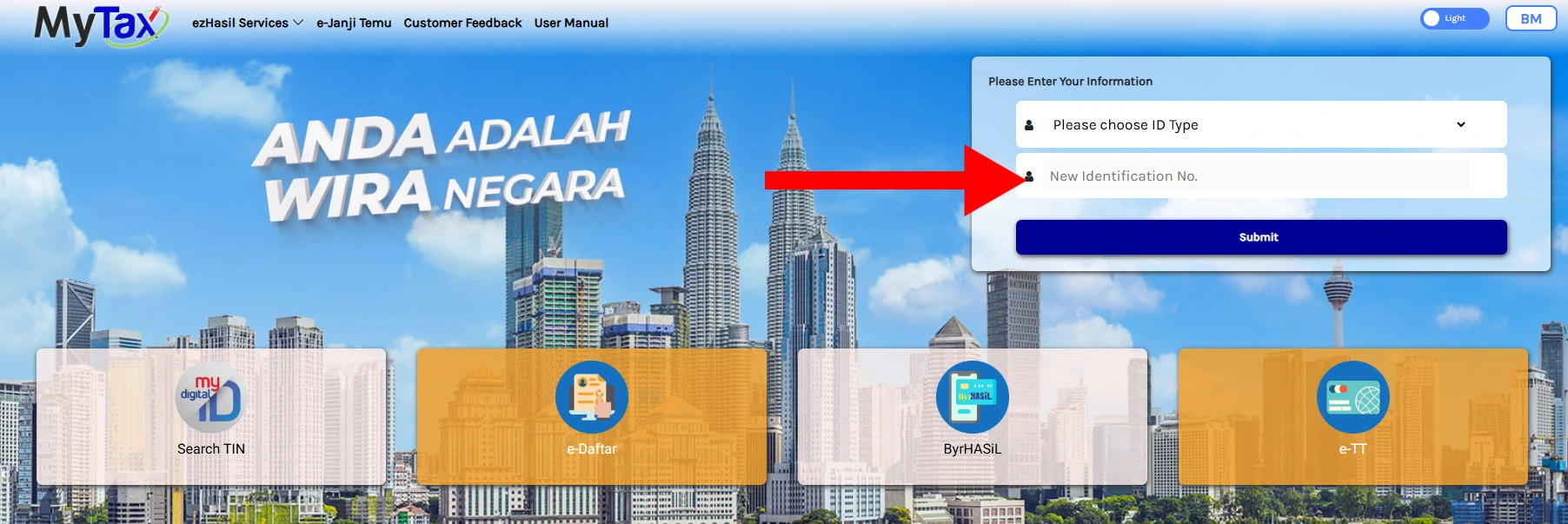
Log in using your Identification Number (IC), Passport number, Army number or Police number, and your password.
Step 2. Choose your tax form
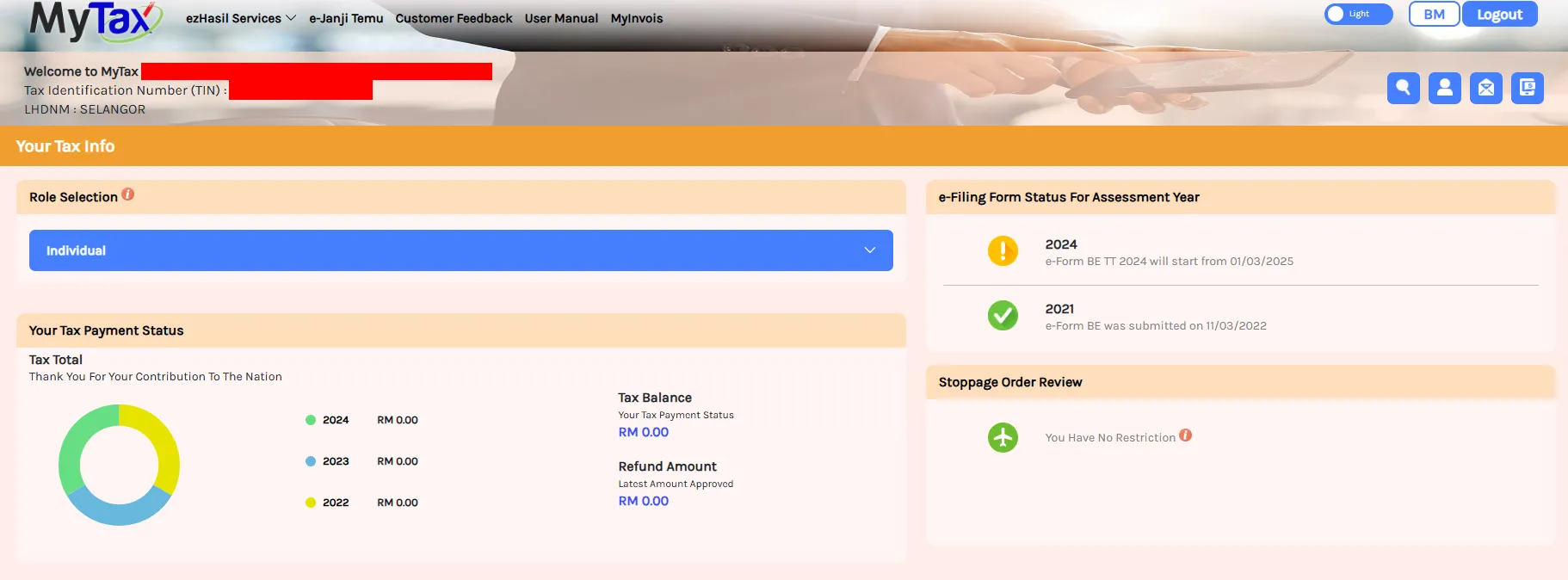
After logging in, you’ll find various tax forms for individuals from different sectors.
Under ‘Status Borang E-filing‘, please select your form accordingly.
Employed individuals will fill up Borang e-BE; self-employed individuals or employers will fill up Borang e-B. If you are a foreigner working in Malaysia, select Borang e-M.
Step 3. Fill in all the details
Next, you’ll see there are different sections in the form.
In ‘Borang e-BE‘, we need to fill in
- Personal Details (Maklumat Individu),
- Statutory Income (Pendapatan Berkanun)
- Tax Deduction/Rebate (Pelepasan Cukai/Tolakan Cukai)
*Pro Tip: Keep all the receipts you used for tax deduction/rebate as you might need to show them to the authorities if you were audited.
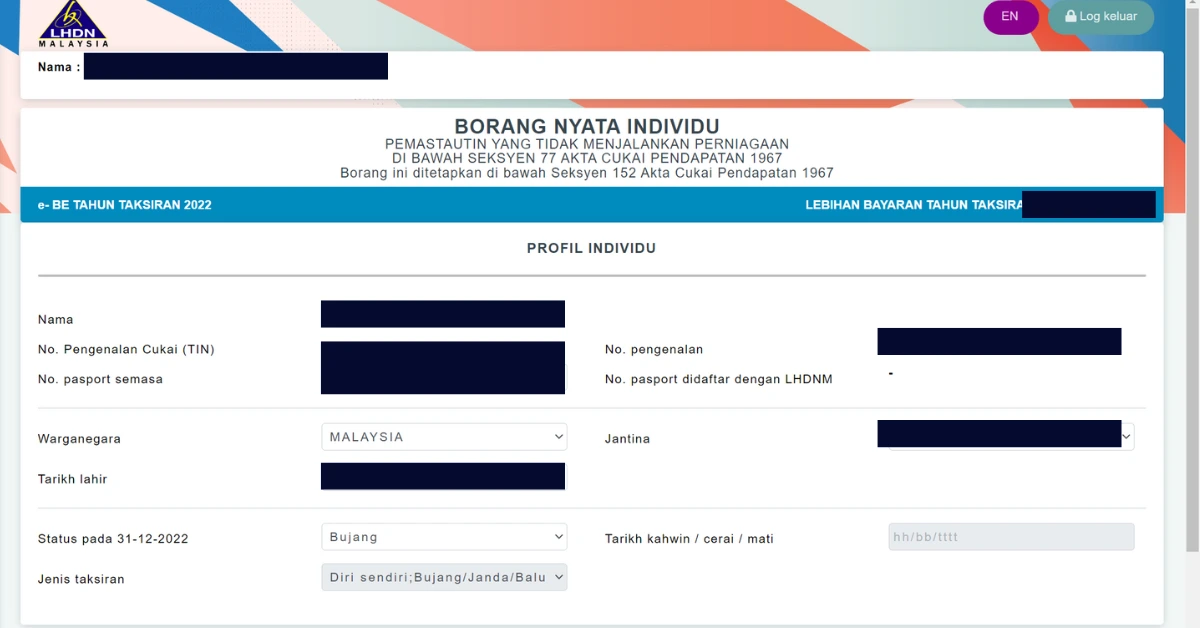
One good thing about filing your tax online is that the system will calculate the chargeable income and tax relief, showing you only the payable tax!
Now you don’t have to worry that you might get it wrong.
*If you don’t meet the taxable threshold after-tax deduction, the system will show 0 in the payable amount.
First, verify your personal details.
Next, other particulars.
Verify your tax information. Make sure to key in your bank account details accurately so that you can receive your tax refund (if any)!
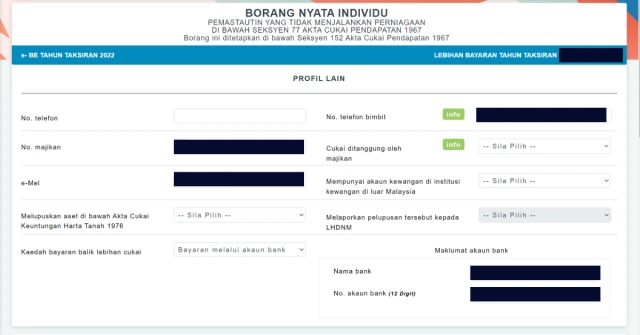
Next, fill in statutory and total income.
This is where you fill in your income! Fill in the information according to the EA form provided by your company. You need to list down any part-time or rental income.
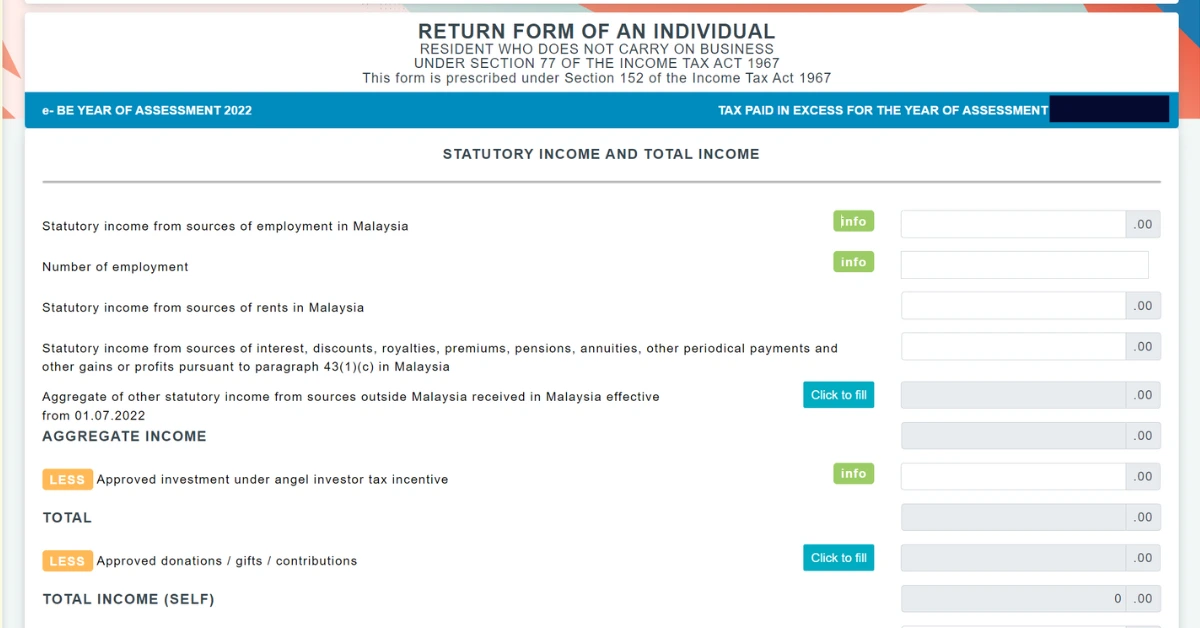
Next, relief.
This is where you claim all of your tax reliefs! Fill in the details and let the system calculate for you.
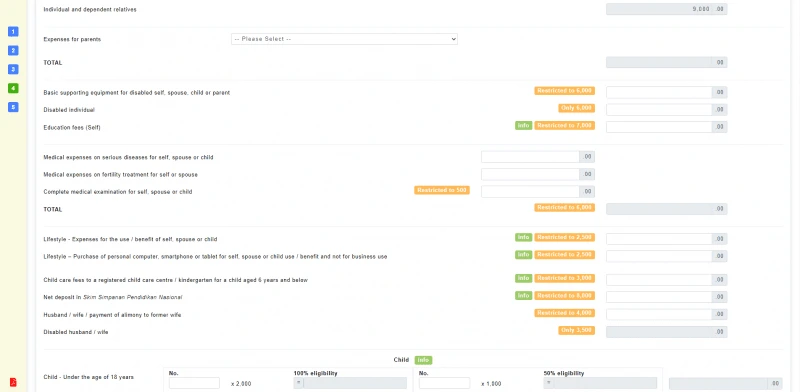
Last but not least, Summary
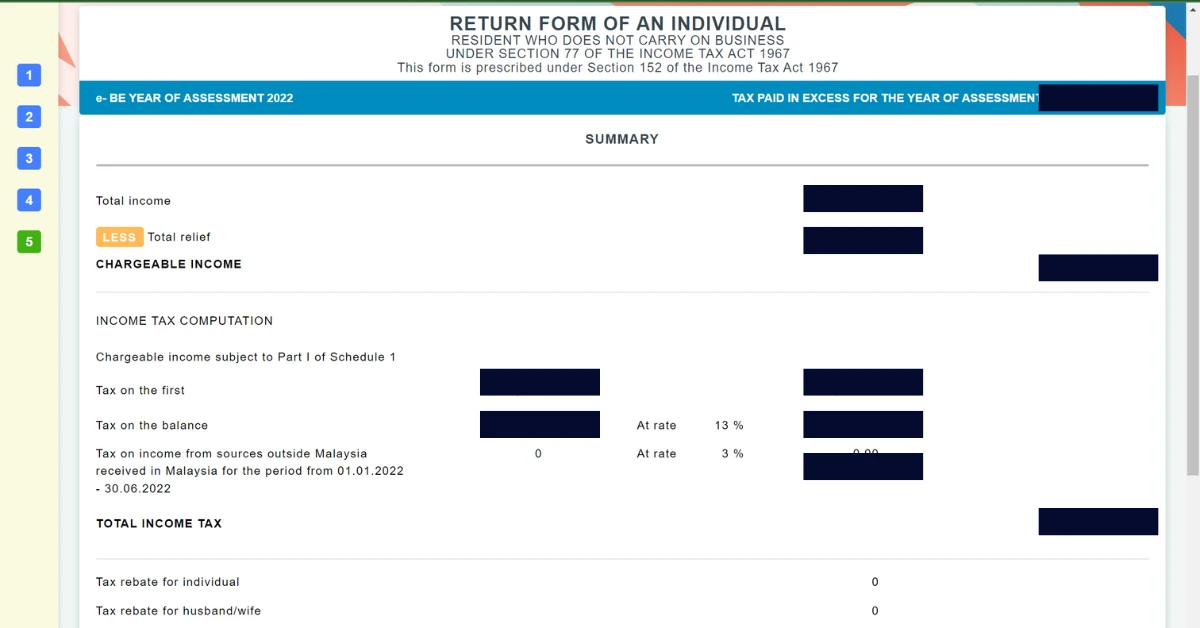
You’re almost done! This page shows you the summary of your income, tax relief and the final payable tax (if applicable).
Make sure to check if all of your details are correct here.
Step 4. Submit
After reviewing your details, click ‘Next‘ under ‘Summary‘ (Rumusan), then click ‘Sign & Submit‘ and it will bring you to the ‘Declaration‘ page.
Before signing, you can click ‘Print Draft‘ to download and save your file.
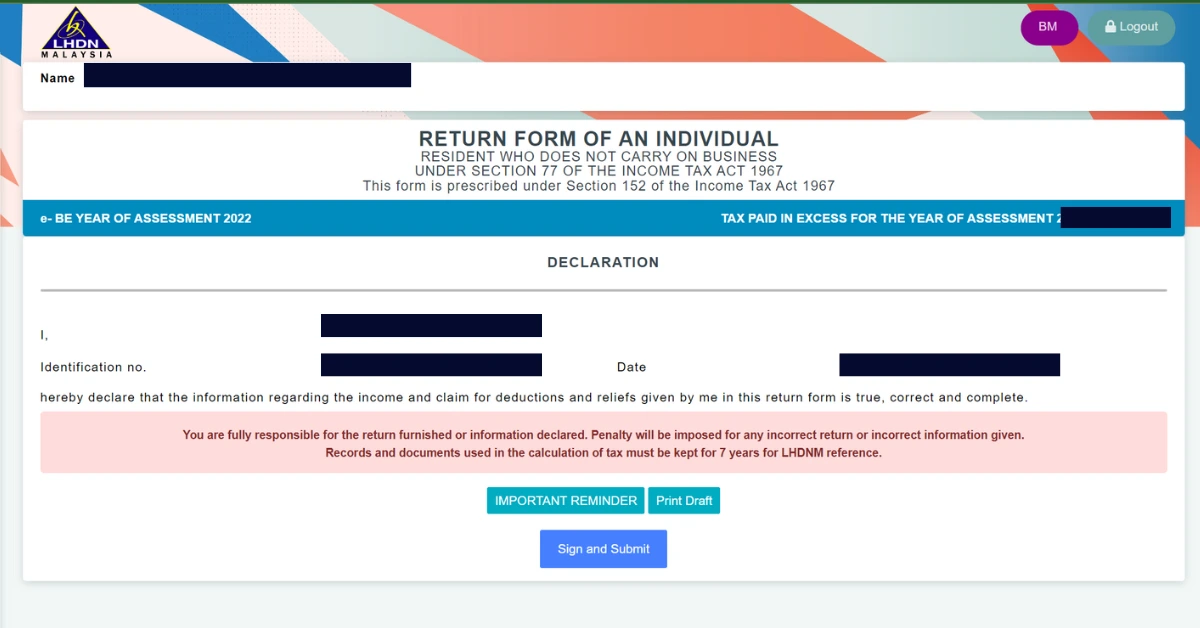
Congratulations, you just finished filing your income tax!
8. How do I file a return after the due date?
If individuals or companies miss the deadline for filing their taxes, they could face penalties.
The penalties include a 10% fine for late filing, as well as fines ranging from RM200 to RM20,000, or imprisonment for up to six months, or both, as stated in the Income Tax Act 1967.
To avoid these penalties, taxpayers should stay informed about the tax deadlines and make sure to file their taxes on time.
9. Extra tips: Filing income tax as a foreigner
Foreigners who stay and work in Malaysia for more than 182 days are subject to tax, and they must file and pay their tax to the Inland Revenue Board of Malaysia.
On the other hand, according to the Income Tax Act 1967, only income derived from Malaysia is subject to income tax in Malaysia, while income earned outside Malaysia is not subject to tax.
For example, Malaysians working in Singapore will have to file and pay their tax in Singapore; thus there’s no need to file and pay their tax to the Inland Revenue Board of Malaysia.
Extra Information:
- If a foreign company employed the taxpayer and he doesn’t work in Malaysia and only provides services abroad, the income will be considered foreign-sourced. There will be no need for the taxpayer to file and pay the income tax in Malaysia.
- But, if the taxpayer provides services for a foreign company through mobile or internet in Malaysia, indicating that his/her income was derived from Malaysia, then he/she must file and pay the income tax.
- If a Malaysian resident individual uses the foreign-sourced income to buy properties and earn rental income in Malaysia, then he/she must pay the income tax.
Frequently Asked Questions (FAQ)
What is the difference between Form BE and Form B?
| Form BE | Form B |
|---|---|
| For individuals who only have income from salary. | For individuals who have business income, such as business owners or freelancers. |
I forgot my e-Filing PIN number. How can I recover it?
You can retrieve it through:
- e-Daftar on the MyTax LHDNM website
- Visit a LHDNM branch
- Request it online through the LHDNM feedback form
How do I know which tax relief and rebates I am eligible to claim?
Check the full list of Tax Reliefs or refer to your purchase receipts. If you buy books, sports equipment, insurance, or save in SSPN, you may be eligible!
What is “Form EA”?
Form EA is an annual income statement from your employer showing your total salary and EPF deductions.
If I overpaid my tax, how can I get a refund?
Make sure your bank account number is correct during e-Filing. If you overpaid, LHDNM will process and deposit the refund into your account.
If I am a foreigner working in Malaysia, do I need to file taxes?
Yes, if you work in Malaysia for more than 182 days in a year, you are considered a tax resident and must file taxes on income earned in Malaysia.
Tired of your 9-5 job? Join over 25,000 real estate agents worldwide, and expand your career globally!
Continue reading:
